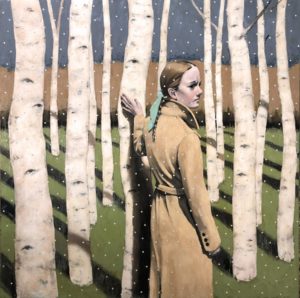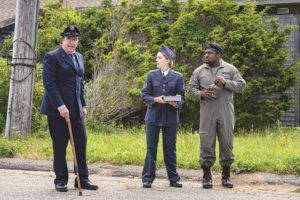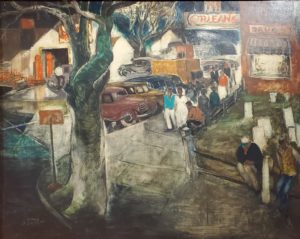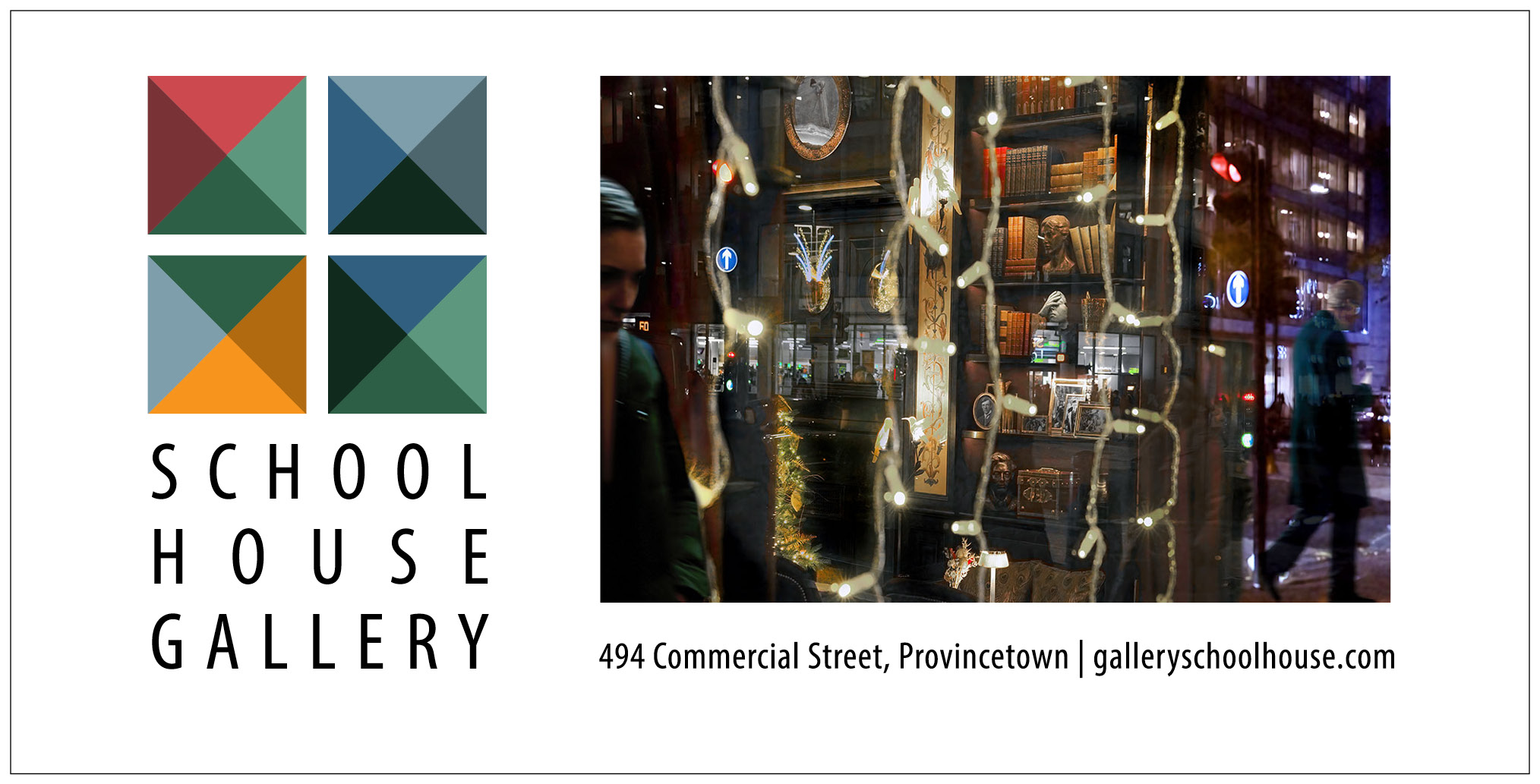Secrets and Lines at AMZehnder Gallery
There’s an elusive quality that connects the work of the three artists featured in a new group show at AMZehnder Gallery in Wellfleet. Gallery owner Anne-Marie Zehnder describes it as “piercing.”

“Each artist has a strong voice and a pounding heart,” says Zehnder. “It’s beautiful and absolutely emotional work.”
Mitra Walter’s finely detailed oil paintings combine almost photographic precision with surreal elements that hint at the complex and ultimately unknowable lives of her subjects. Laura Peturson’s linotypes, seemingly light on the surface, are full of details that convey a more mysterious reality: witness the bare, sharp branches of the tree growing outside the window in the curiously titled Summer Reading, or the lone young girl with an inner tube on the edge of a pond — lost, abandoned, or simply enjoying her own company on a summer day — in Low Tide Cove.
Caroline Bowden’s portraits depict young subjects accompanied by the empty outlines of their own doppelgängers, suggesting both an enigmatic parallel existence and the unrealized potential of a future self.
The show runs through Sept. 7 at 25 Bank St., with an opening reception on Saturday, Aug. 27 from 6 to 8 p.m. —John D’Addario
Falling in Love with Old Cape Cod, Again
When Eastham native Dawn Derow sings about sand dunes and salty air, she’s not just covering Patti Page (who never visited the Cape until after she recorded “Old Cape Cod” in 1957). She’s evoking memories.

“I’m so happy we’re doing that song,” says Derow of her performance with the Cape Symphony at the Salt Pond Visitor Center in Eastham on Friday, Aug. 26 at 7 p.m. “Whenever I sing the part about the ‘winding roads that seem to beckon you,’ I think of driving from our house in Eastham to the restaurant my father used to own in Wellfleet.” (Derow’s father co-owned the Lighthouse Restaurant on Main Street until 2008.) “The whole song, and being able to sing ‘back home,’ is very nostalgic for me.”
Symphony Director Jung-Ho Pak will lead the orchestra in a program that includes works by Antonio Vivaldi and Aaron Copland, a Disney medley, and “Wampanoag: Stories for All Time” by Native American composer Tonya Wind Singer.
A multimedia celebration of the Cape Cod National Seashore, a discussion between Pak and Mark Faherty of the Wellfleet Bay Wildlife Sanctuary about the relationship between bird songs and music, and a musical tribute to our armed forces and veterans will round out the evening.
Admission is free. Preconcert activities for kids and parents will be offered from 6 to 6:45 p.m. The rain date is Saturday, Aug. 27; updates will be posted on capesymphony.org the day of the scheduled performance. —John D’Addario
Laura Ortman at FAWC

Laura Ortman will close out the summer season at the Fine Arts Work Center in Provincetown with a performance on Saturday, Aug. 27 at 7 p.m. An experimental violinist, Ortman crosses boundaries between the worlds of music and fine arts. In 2008, she founded the Coast Orchestra, an all-Native American ensemble, and since then has performed at the Museum of Modern Art, the Centre Pompidou in Paris, and the 2019 Whitney Biennial.
Born on the White Mountain Apache reservation in Whiteriver, Ariz., Ortman grew up near St. Louis and has lived in New York for more than 20 years. Ortman’s grandmother, also a violinist, inspired her to take up the instrument. Although she has played in orchestras, her current performances are improvisational: in a 2020 interview during her fellowship at the Socrates Sculpture Park in New York, she said, “I work really hard on being malleable to the situation.” —Abraham Storer
A Social Justice Hero, in Color
Barney Frank gets the hero’s treatment he deserves in SMAHTGUY: The Life and Times of Barney Frank, a graphic novel by Eric Orner that tells the story of the 16-term Massachusetts Congressman and gay rights pioneer in colorful and fearlessly outspoken detail.

Best known for his syndicated comic strip The Mostly Unfabulous Life of Ethan Green, Orner is uniquely qualified to tell the story of the New Jersey-born, Harvard-educated, and self-described “left-handed gay Jew” who became a singular force for social justice: at various times over the years he served as Frank’s press secretary and staff counsel.
Frank and Orner will be discussing the book at the Provincetown Public Library at 361 Commercial St. on Saturday, Aug. 27 at 6 p.m. Signed copies will be available for purchase.
“I always thought that Barney Frank would be the perfect subject when I decided to work on a graphic novel,” says Orner. “His life story is so compelling, and he’s been so much of an inspiration. And most important for a cartoonist, he’s funny! Part of his appeal is that he’s always played against type for a politician. He’s not all toothy smiles and handshakes — in fact, he most often comes off as a grouch. But he has a big heart, and it’s evident that his electorate has always responded to that.”
The novel comes at a fraught time in the U.S. “People have so little faith in politics these days,” says Orner. “So, telling the story of someone who was able to accomplish things to make a better world was very gratifying.”
Registration is required for both the in-person and online versions of the event. Tickets are $5. See facebook.com/EastEndBooks for more information. —John D’Addario
Taro Yamamoto at Bakker Gallery
The Bakker Gallery at 359 Commercial St. in Provincetown is reintroducing the work of Tara Yamamoto, much of which hasn’t been seen in recent years. The exhibition, on view through Sept. 5, includes eight of his paintings made over a 40-year period starting in the 1950s.

“Over the years, he changed his style and was always trying new things,” says his son, Vincent Yamamoto, who lives in Orleans. The works display an exuberant use of color and a curiosity about exploring different approaches to nonobjective painting. His shifting influences are apparent: there’s a hard-edged, primary-color piece that resembles a Mondrian painting; a couple of drippy Pollock-inspired canvases from the 1950s; and some messy abstractions overlaid with shapes reminiscent of Hans Hofmann. In the 1980s and ’90s, he seems to have found his voice more fully in a group of juicy, colorful works. Tulips, from 1988, feels radical and fresh. Looking like a palette wet with paint, it reads as a painting coming into being.
Yamamoto’s biography is as fascinating as his art. Born in Hollywood in 1919, the son of a wealthy farmer and developer, Yamamoto was sent to live in Japan at age 6, where he remained until the start of World War II. He joined the U.S. Army during a time when many Japanese-Americans, including his own family, faced discrimination and internment. With the support of the G.I. Bill, he attended the Art Students’ League in New York, a connection that eventually brought him to Provincetown in 1951 to study with Hofmann. He returned to the Outer Cape in the 1970s to live in Wellfleet, where he remained until his death in 1993. —Abraham Storer
Under the Radar at Payomet
Under the Radar is a play, but it’s much more than that. Written by Kevin Rice and directed by Daisy Walker, the interactive, immersive comedy treats the audience as newly arrived airmen of the 762nd Air Force Squadron in June 1969 about to embark on a 12-month tour of duty in North Truro.

The play moves from the Payomet Performing Arts Center to the more unnerving Highland Center, an abandoned military base adjacent to Payomet. The audience-airmen are treated to a tour of their lodgings for the next year.
What exactly is the mission of these airmen? To find the Communists, of course. And who exactly are the Communists? “Subscribers to the New Yorker magazine,” one of the actors explains. The comedy comes with a fair share of relevance: what exactly is this whole military industrial complex thing anyway?
The play runs at Payomet on weekdays until Sept. 2 with showtimes at 10:30 a.m. and 5 p.m. Tickets, available at payomet.org, are $25 or $20 for students, educators, and veterans. —Paul Sullivan
Vernon Smith’s Orleans
Orleans-based artist Vernon Smith (1894-1969) approached art with an unpretentious curiosity. A show of his work at the Centers for Culture and History in Orleans, on view through Sept. 30, includes paintings, wood carvings, batik designs, illustrations, and even a lamp with a carved base and painted shade.

Smith didn’t just move comfortably between art forms but also between styles. He was especially influenced by Cubism. In Dock With Boats and Camp Races, boats and sails become a jumble of geometric shapes. In later woodcuts, natural forms are transformed: lines and curves cut through the imagery, often yielding purely abstract compositions.
One thing remained constant: the town of Orleans as subject and muse. The heart of this exhibition is a series of street scenes of mid-century life in Orleans: patrons walking out of the cinema, the town graveyard, a World War II victory celebration, and the local Mobil station. Smith’s output included art for the Church of the Holy Spirit and a design for the banner of the Cape Codder newspaper that is still in use. As a supervisor of artists under the WPA’s Federal Art Project, Smith reflected the populism and regionalism of the era in his work. —Abraham Storer



